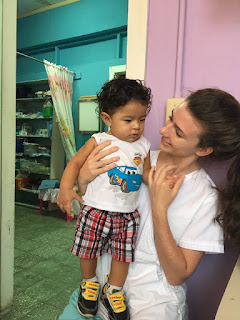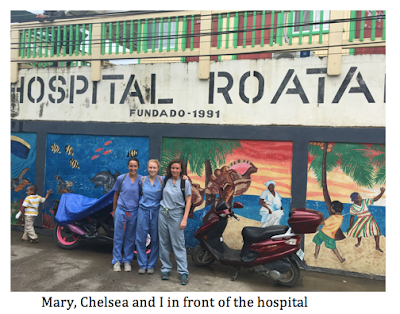Lia (July-Aug 2017)
When I arrived in Roatán an employee of Clinica Esperanza
picked me up from the airport. He drove a bright orange
van, the back of which bounced frequently, hitting the pavement as we dodged
potholes. I took in my new home for the month on the way to my apartment, as we
made our way down the singular road that runs the length of the island. On
Roatán the resorts neighbor the poverty. The contrast between the two was
visible just in the drive from the airport, as we passed huge hotels that sat
just adjacent to smaller convenience stores and houses in need of repair. This
contrast was perhaps most exemplified in the pediatric inpatient room of the
hospital, where necessary equipment and medications are often in short supply
and mothers sit by their children’s beds in donated cruise ship chairs. The
juxtaposition between vacation and the crude reality of poverty exist so close
to one another on the island, yet the two rarely intersect.
My
days at the hospital began with rounds with the pediatric doctor. We began in
the emergency room, and then made our way through the pediatric inpatient room,
the NICU, and then to examine the newly born babies in the maternity ward. Should
a child be held in the isolation room, we would put on thick masks and visit
them too. Following this, we would make our way to the pediatric clinic, where
I would help triage the patients before they were seen by the doctor. I
measured the height, weight, temperature, and head circumference, if
appropriate, before each patient saw the doctor. Through seeing so many
different areas of the hospital, I was able to see a variety of diagnosis,
ranging all the way from TB to healthy checkups.
One of the most rewarding parts of spending
time in the hospital is seeing kids the whole way through the process: from
admission until the time that they are well enough to get to go home. I
distinctly remember an instance in which a 1 and a half year old little boy was
discharged. After having felt so sick and having been so upset for much of his
time in the hospital, when the doctor told his mom they could go home that day,
his little face lit up. He ran right up to me to be picked up just after, and
pointed to the door expectedly; it absolutely melted my heart. There were other
times when moms that I recognized from the NICU would come for a well check-up
in the clinic, and I would share in their excitement as I weighed their baby
and we marveled over how much they had grown.
There was one day in particular that a
visiting doctor was seeing HIV positive children in the clinic. I remember this
day distinctly because I was so impressed with how the doctor spoke with each
child, navigating what can be such a delicate situation. Some of the
children, who were younger, were not yet aware of their diagnosis. During visits
such as these I sat with the children outside of the patient room so that the
doctor could speak with the parents. One little girl in particular was very
excited to speak to me because she could practice her English, which she was
learning at school. She told me that when she grew up, she wanted to be a
doctor, and spent the visit asking me all kinds of questions. Her school, a
Canadian non-profit, was one that I would later visit to volunteer. During my
visit, just after I got to the school, when I was standing inside filling up a
water bottle her head popped through the window, and excitedly yelled my name.
She ran inside to give me a hug. Later, one of her friends would shyly walk up
to me too, tapping on the pant leg of my scrubs, before giving me a quick hug
and then running back to her friends. One of the most memorable visits that
day, however, was with a boy who was aware of his diagnosis. He was 12, and in
the 6th grade, which is the last grade during which children can
attend school for free on the island. After this, either parents must pay for
education, or children may stop going to school altogether. The doctor talked
with the boy about his interests, and what he wanted to do when he was grown up.
She talked to him about the precautions that he would need to take when dating,
and emphasized the importance of remembering to take his medicine daily as
prescribed. Most importantly however, she reminded him firmly that he was just
the same as any other 12 year old boy, the only difference being that he had to
take his medicine. She made sure that he knew that he could live a wonderful
life, despite his diagnosis, and that he should not shy away from pursuing any
of his dreams.
The
hospital is notably different from what we picture a hospital as in the U.S.
The system is all paper, and every patient’s chart is kept in a manila folder,
stacked in impressive numbers in a room just next to the hospital entrance.
It’s not abnormal for papers to be lost, or for some of the information on a
patient to be missing. There is water damage visible on the ceilings, holes in
some of the walls, and tiles missing in places in the floor. The rooms are
small, and privacy is lacking as most patients’ beds are sit right beside one
another. Most important, however, is that the hospital sometimes lacks needed
medications, or equipment needed to treat patients. In cases such as these,
patients need to be transported to the mainland, to either San Pedro Sula, or to
the capital, Tegucigalpa. The trip is unimaginably long and incredibly
expensive for many families, something especially daunting to face while caring
for a sick child. The doctors and nurses, however, don’t let any of these
challenges phase them, and approach any situation complicated by a lack of
supply with calm determination and care. It is visible how much they care for all
the patients who they treat, and they treated me with the same kindness. My
very first day at the hospital the pediatric doctor made sure I had her phone
number, and let me know that if I ever needed anything I could text her. She even
sent me a message the day I left, asking if I was home safe in the U.S.
In
my time outside of the hospital, and the clinic, I explored the island with
other medical volunteers. Of everything we did scuba diving was by far my
favorite. Imagine flying, underwater, in Finding Nemo. It’s as good as it gets.
There was never a dull moment, and I’ve been wanting to return ever since my
plane landed here in North Carolina; they weren’t kidding about the island
fever.






Hi dear,
ReplyDeleteThank you for this wonderful post. It is very informative and useful. I would like to share something here too.Green Health Canada Inc is a renowned Canadian Medical Supplies provider that deals in Exa-one surgical gowns, isolation and hospital gowns, etc. We specialize in Canadian-made products and provide customers with the highest quality medical supplies. Visit our website to know more.
D-Capture Drill Dust